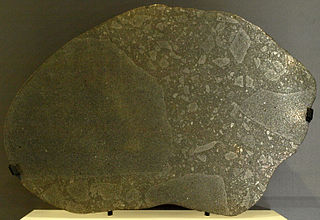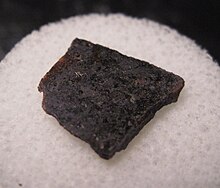
The giant-impact hypothesis, sometimes called the Big Splash, or the Theia Impact, suggests that the Moon was formed from the ejecta of a collision between the early Earth and a Mars-sized planet, approximately 4.5 billion years ago in the Hadean eon. The colliding body is sometimes called Theia, named after the mythical Greek Titan who was the mother of Selene, the goddess of the Moon. Analysis of lunar rocks published in a 2016 report suggests that the impact might have been a direct hit, causing a fragmentation and thorough mixing of both parent bodies.

A Martian meteorite is a rock that formed on Mars, was ejected from the planet by an impact event, and traversed interplanetary space before landing on Earth as a meteorite. As of September 2020, 277 meteorites had been classified as Martian, less than half a percent of the 72,000 meteorites that have been classified. The largest complete, uncut Martian meteorite, Taoudenni 002, was recovered in Mali in early 2021. It weighs 14.5 kilograms and is on display at the Maine Mineral & Gem Museum.

A chondrite is a stony (non-metallic) meteorite that has not been modified, by either melting or differentiation of the parent body. They are formed when various types of dust and small grains in the early Solar System accreted to form primitive asteroids. Some such bodies that are captured in the planet's gravity well become the most common type of meteorite by arriving on a trajectory toward the planet's surface. Estimates for their contribution to the total meteorite population vary between 85.7% and 86.2%.
P-type asteroids are asteroids that have low albedo and a featureless reddish spectrum. It has been suggested that they have a composition of organic rich silicates, carbon and anhydrous silicates, possibly with water ice in their interior. P-type asteroids are found in the outer asteroid belt and beyond. There are in the neighborhood of 33 known P-type asteroids, depending on the classification, including 46 Hestia, 65 Cybele, 76 Freia, 87 Sylvia, 153 Hilda, 476 Hedwig and, in some classifications, 107 Camilla.

An achondrite is a stony meteorite that does not contain chondrules. It consists of material similar to terrestrial basalts or plutonic rocks and has been differentiated and reprocessed to a lesser or greater degree due to melting and recrystallization on or within meteorite parent bodies. As a result, achondrites have distinct textures and mineralogies indicative of igneous processes.

Space weathering is the type of weathering that occurs to any object exposed to the harsh environment of outer space. Bodies without atmospheres take on many weathering processes:

Extraterrestrial material refers to natural objects now on Earth that originated in outer space. Such materials include cosmic dust and meteorites, as well as samples brought to Earth by sample return missions from the Moon, asteroids and comets, as well as solar wind particles.

Enstatite chondrites are a rare form of meteorite, rich in the mineral enstatite. Only about 200 E-Type chondrites are currently known, comprising about 2% of the chondrites that fall on Earth. There are two main subtypes: EH and EL, classified based on their iron content.
CI chondrites, also called C1 chondrites or Ivuna-type carbonaceous chondrites, are a group of rare carbonaceous chondrite, a type of stony meteorite. They are named after the Ivuna meteorite, the type specimen. CI chondrites have been recovered in France, Canada, India, and Tanzania. Their overall chemical composition closely resembles the elemental composition of the Sun, more so than any other type of meteorite.

The Late Heavy Bombardment (LHB), or lunar cataclysm, is a hypothesized event thought to have occurred approximately 4.1 to 3.8 billion years (Ga) ago, at a time corresponding to the Neohadean and Eoarchean eras on Earth. According to the hypothesis, during this interval, a disproportionately large number of asteroids and comets collided with the early terrestrial planets in the inner Solar System, including Mercury, Venus, Earth and Mars. These came from both post-accretion and planetary instability-driven populations of impactors. Although it used to be widely accepted, it remained difficult to provide an overwhelming amount of evidence for the hypothesis. However, recent re-appraisal of the cosmo-chemical constraints indicates that there was likely no late spike in the bombardment rate

Nakhlites are a group of Martian meteorites, named after the first one, Nakhla meteorite.
The Itqiy meteorite is an enstatite-rich stony-iron meteorite. It is classified as an enstatite chondrite of the EH group that was nearly melted and is therefore very unusual for that group. Other classifications have been proposed and are an ongoing scientific debate.
This is a glossary of terms used in meteoritics, the science of meteorites.

Northwest Africa 7034 is a Martian meteorite believed to be the second oldest yet discovered. It is estimated to be two billion years old and contains the most water of any Martian meteorite found on Earth. Although it is from Mars it does not fit into any of the three SNC meteorite categories, and forms a new Martian meteorite group named "Martian ". Nicknamed "Black Beauty", it was purchased in Morocco and a slice of it was donated to the University of New Mexico by its American owner. The image of the original NWA 7034 was photographed in 2012 by Carl Agee, University of New Mexico.

Northwest Africa 7325, also known as NWA 7325, is a unique igneous meteorite which crystallized as a basalt on a large asteroid or planetesimal approximately 4.56 billion years ago. It is classified as an ungrouped achondrite, and is notable for its green fusion crust and high-magnesium/low-iron composition. It was purchased from anonymous finders in a marketplace in Erfoud, Morocco in April 2012. The original find was composed of 35 fragments with a combined weight of approximately 345 grams (12.2 oz), however many additional fragments with a total weight of over 1,100 grams (39 oz) were subsequently recovered.
Robert Norman Clayton was a Canadian-American chemist and academic. He was the Enrico Fermi Distinguished Service Professor Emeritus of Chemistry at the University of Chicago. Clayton studied cosmochemistry and held a joint appointment in the university's geophysical sciences department. He was a member of the National Academy of Sciences and was named a fellow of several academic societies, including the Royal Society.
Bunburra Rockhole is an anomalous basaltic achondritic meteorite. Originally classified as a eucrite, it was thought to belong to a group of meteorites that originated from the asteroid 4 Vesta, but has since been reclassified based on oxygen and chromium isotopic compositions. It was observed to fall on July 21, 2007, 04:43:56 local time, by the Desert Fireball Network (DFN). Two fragments weighing 150g and 174g were recovered by the DFN at 31°21.0′S, 129°11.4′E in the Nullarbor Desert region, South Australia in November of the same year. This is the first meteorite to be recovered using the Desert Fireball Network observatory.

Toshiko K. Mayeda was a Japanese American chemist who worked at the Enrico Fermi Institute in the University of Chicago. She worked on climate science and meteorites from 1958 to 2004.
Asteroidal water is water or water precursor deposits such as hydroxide (OH−) that exist in asteroids. The "snow line" of the Solar System lies outside of the main asteroid belt, and the majority of water is expected in minor planets. Nevertheless, a significant amount of water is also found inside the snow line, including in near-earth objects (NEOs).
CM chondrites are a group of chondritic meteorites which resemble their type specimen, the Mighei meteorite. The CM is the most commonly recovered group of the 'carbonaceous chondrite' class of meteorites, though all are rarer in collections than ordinary chondrites.












